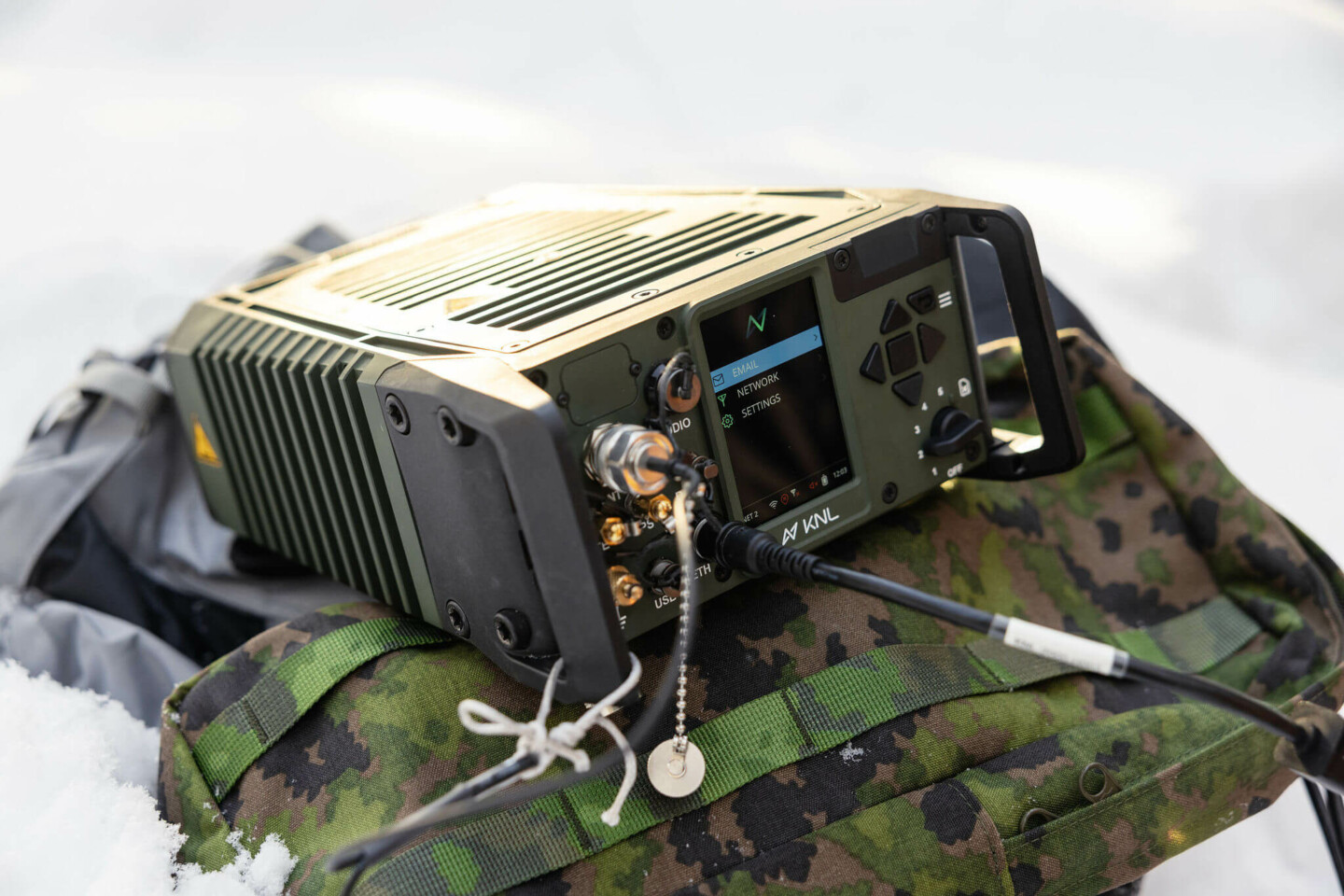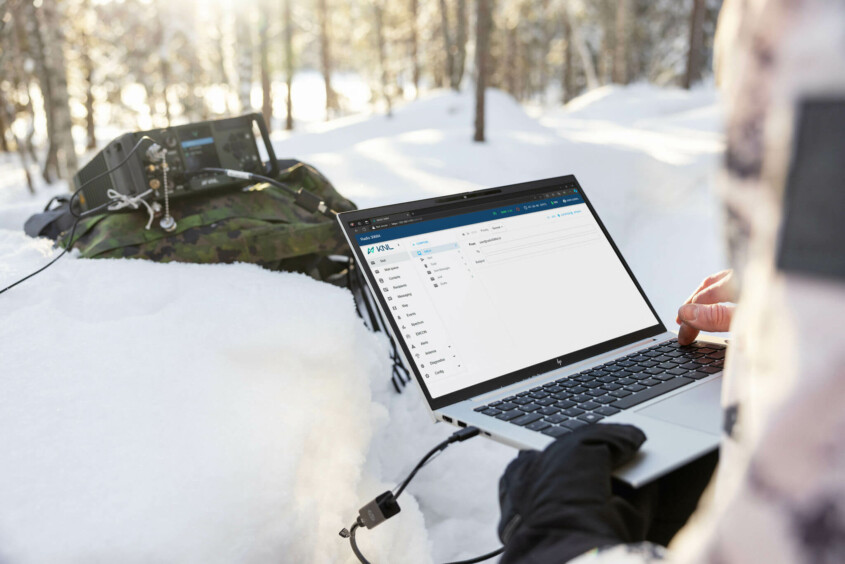🇫🇮 KNL’s strategy for software-defined radios: Balancing security, easy integrations, and user-friendliness

Software-defined radios (SDRs) offer a dynamic and flexible approach to wireless communication, and as a result, they have become increasingly common in the field of defence and military communication.
In this blog post, we’ll explain the basics of software-defined radio and how KNL has perfected the development of software-defined cognitive radios to the highest standards.
Long-range connectivity and unparalleled performance with software-defined radios
KNL’s software-defined, cognitive radios enable secure, reliable, and fast data links in any operating environment. KNL’s radios are designed to exceed users’ expectations, offering superior performance also in scenarios where legacy HF radios may face limitations.
KNL’s radio technology utilises real-time spectrum information to identify available channels for digital data transmission. Our software-defined radios continuously monitor the entire HF spectrum, which allows us to detect hostile jamming and unintentional interference with great accuracy.
The design of our software-defined radios simplifies integrations to other operational systems and enables product customisation to meet your unique requirements. KNL’s SDRs are equipped with standard interfaces utilised in defence and security.
Benefits such as flexibility, adaptability, reliability, and seamless integration make KNL’s radios valuable tools for modern military operations.
What is a software-defined radio?
A Software-Defined Radio (SDR) is a radio communication system that utilises reconfigurable software-based components. Crucial parameters such as carrier frequency, signal bandwidth, and network access are defined through software. By separating the hardware components from the software, these radios can support multiple frequency bands and waveforms, adapt to different communication protocols, and offer effortless system upgrades.
Compared to traditional radios, software-defined radios offer high flexibility and adaptability.
KNL’s radio technology sets high standards for software-defined radio systems
KNL’s software-defined radios are designed for voice and data communications, so users can transfer and receive multiple data types without compromising reliability. Not only that, but the equipment is so simple to operate that practically immediate response can be provided even if there is very little time to train new radio operators.
The disadvantages associated with SDRs may relate to complexity, latency, signal integrity and interference or security vulnerabilities. We at KNL overcome these issues with our advanced software-defined radio technology.
”As a true Software-Defined Radio the KNL platform offers a future-proof solution for continuous development work according to the customer needs.”
The technology behind the KNL system combines traditional HF terrestrial radio technology with modern cognitive technologies. KNL’s software-defined radios can detect the wireless spectrum and automatically change its transmission or reception parameters according to what optimal wireless channel is available. As a result, KNL offers significantly improved performance and reliability, which opens new use cases previously beyond the realm of HF technology. Furthermore, the KNL system can be fully integrated into other C2 and communications systems. Additionally, our equipment is secure by design, ensuring data and communication confidentiality and integrity.
KNL’s SDRs are:
- Ultra-secure and capable of automatically changing frequencies to a safe/clear one if it encounters interference or recognises it is being jammed.
- Effortless to use – a significant advantage when there is little time to train new radio operators.
- Capable of receiving and transmitting data reliably in multiple formats such as voice, video, text, and images. KNL’s radios enable wideband HF communications at up to 300 kbps for various media formats.
- Reliable even in extreme weather temperatures (from -40°C to +55°C)
- Extremely fast in link establishment, with the Automatic Link Establishment being much faster than with 3G/4G ALEs, reducing setup time to just 0.5 seconds.
Read more: Why KNL’s radios are the ultimate choice?
KNL’s Software-Defined Radios integrate easily into C2 and messaging systems
Software-defined radio represents a future-proof solution, allowing for continuous upgrades of new features and capabilities throughout the product’s lifecycle.
KNL’s SDRs have standard interfaces, so integration into other systems is easy and straightforward.
The standard interfaces of our software-defined radios include:
- UDP/IP
- SMTP and IMAP interfaces for external email client and server
- XMPP interface for external XMPP client and server (makes integration into NATO’s JChat possible)
Compared to other wideband HF radio systems, our equipment stands out for its straightforward integration capabilities. KNL’s equipment enables seamless interoperability with C5ISTAR systems, networks, and radios in the field, supporting better real-time situational awareness – the key to success in modern full-scale warfare.
Read more: KNL radios deliver on the promise of HF renaissance
Developing new features in collaboration with defence forces
KNL is dedicated to building exceptional HF radio solutions that are easy to operate while adhering to the strictest safety standards and operational requirements. Our advanced technology is evolving in collaboration with our customers.
The Finnish Defence Forces (FDF) and KNL have been successfully developing the CNHF1 system for several years. Consistent development continues with FDF’s software update order from KNL.
Read more: Finnish Defence Forces and KNL continue software development work
Get Connected with software-defined radios
Experience our software-defined cognitive radios’ capabilities and product features as we continue to deliver technological excellence for defence and security professionals worldwide.
Read more about partnership with KNL, explore our products or contact us for detailed information!
Summary: The benefits of a software-defined radio vs traditional radio
- Generally, software-defined radios offer greater flexibility and adaptability than traditional radios.
- A software-defined radio allows for easy updates and makes remote configurations possible. Thus, they can be more cost-effective over the long term.
- Software-defined, cognitive radios can adapt to changing frequency and bandwidth requirements, optimising spectrum usage and reducing interference vs. traditional radios, which are typically limited to specific frequencies or modes.
- Software-defined radios have a broader frequency range than traditional radios, enabling them to cover a wider spectrum.
Originally published on 16 March by KNL.
Announcements are published as a service to readers. The sender is responsible for all content.
Announcements for publication can be submitted to pr***********@ar**************.com.
